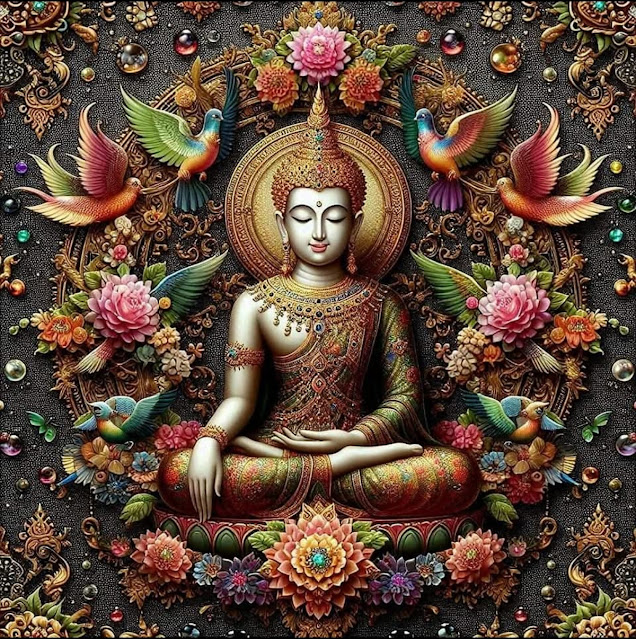Chapter 4 — Mantra Recitation and Daily Energy Transformation
Unveiling Vajrayana Practice in Daily Life — Series 2
In Vajrayana Buddhism, mantra recitation is far more than repeating sacred sounds — it is a method to transform our inner vibration, redirect emotional patterns, and reshape how we experience the world. When understood correctly, mantras become a powerful tool to align body, speech, and mind with awakened qualities.
1. Why Mantras Matter in Vajrayana
In the Vajrayana tradition, the human experience is understood not merely through thoughts and behaviour, but through energy. Every emotion, habit, and reaction is a movement of subtle energy. Mantras directly influence this energetic level. When we recite a mantra, we are tuning our inner frequency — the same way a musical instrument resonates when struck.
From this view, mantra is not only for meditation sessions. It is a method to re-align our inner state throughout daily life. We recite not to please a deity, but to activate the qualities that deity represents — compassion, clarity, courage, wisdom.
2. Sound as Energy: How Mantras Transform the Mind
Every sound vibration carries a specific energetic signature. Vajrayana practitioners believe that mantras are syllables spoken by enlightened beings, carrying the frequency of awakened mind. When these sounds are repeated, the mind starts resonating with that same quality.
For example, reciting Om Mani Padme Hum is not about chanting a phrase in Tibetan. It is an energetic practice to awaken compassion. Reciting Om Ah Hung purifies body, speech, and mind. Reciting Tayatha Om Bekandze Bekandze Maha Bekandze invokes healing energy.
Over time, the mind reshapes itself around the qualities invoked — softer, clearer, less reactive.
3. Mantra Recitation in Daily Life
One of the unique features of Vajrayana Buddhism is that mantra practice can be woven into everyday situations. You do not need a shrine or incense. You simply apply awareness in the present moment.
- While walking: synchronize your footsteps with a mantra rhythm.
- During stressful moments: quietly recite a calming mantra to stabilize your mind.
- Before meetings or conversations: recite to invoke clarity and compassion.
- Before sleep: chant softly to reset and purify your energy.
- While driving: use the time to recite with mindfulness (not loud chanting that distracts).
Mantra becomes a subtle companion, guiding your internal energy throughout the day.
4. The Role of Breath in Mantra Practice
Breath and energy are deeply connected. When mantra is coordinated with breathing, its impact becomes stronger. Try:
- Inhale: Om
- Exhale: Mani Padme Hum
This method instantly settles the body and brings awareness to the heart center.
5. Mantra as Emotional Transformation
In Vajrayana psychology, emotions are not considered enemies. Instead, they are powerful energies that can be transformed into wisdom. Mantra acts as the bridge between raw emotion and its enlightened quality.
- Anger transforms into clarity and courage.
- Desire transforms into discriminating wisdom.
- Fear transforms into spaciousness.
- Confusion transforms into inner stability.
When an emotion arises, reciting mantra channels its energy instead of suppressing or acting on it.
6. The Three Levels of Mantra Recitation
Traditional Vajrayana texts describe three methods of recitation:
- Vocal recitation — audible chanting; good for beginners to stabilize focus.
- Whisper recitation — soft chanting where only you can hear; deepens concentration.
- Mental recitation — the most subtle and powerful; mantra is recited in the mind without sound.
All three methods have their purpose. Over time, practice naturally becomes more internal and effortless.
7. Building a Daily Mantra Habit
Mantra practice becomes transformative when it is consistent. You can start with:
- 5 minutes in the morning
- Short recitations during breaks
- Mantra walking after meals
- Evening chanting before sleep
Let mantra become a thread that weaves through your day, steadily reshaping your inner energy.
Conclusion
Mantra recitation is one of the most effective Vajrayana methods for transforming your energy, emotions, and perception of the world. With regular practice, you will begin to notice moments of clarity, compassion, and ease emerging even in the middle of daily life.
This is how mantra becomes more than a practice — it becomes a way of living.
If my writings or reflections resonate with you, you may support this Dharma page here — subscription starts from MYR 2.49/month (≈ USD 0.60)
FootnoteThis article is intended solely for general illustration and educational reading. It does not disclose any secret tantric texts or teachings, and makes no attempt to transmit esoteric instructions that are restricted or require formal empowerment.
All effort has been made to respect the sacred boundaries of Vajrayana practice and to uphold the integrity of samaya vows and Dharma protectors.
Thank you for reading. May you find peace and great bliss. Your support helps spread the Buddha’s precious teachings and turn the Dharma wheel in the world.
Aspiration for Bodhichitta:
May the precious Bodhichitta, which has not yet arisen, arise and not diminish, but rather increase further and further.
Dedication of Merit:
By this merit, may we swiftly attain omniscience. Having overcome the enemies of wrongdoing, may we liberate all beings from the ocean of existence, with its stormy waves of birth, old age, sickness, and death.
I do not own or infringe any copyright on
the picture(s).
Picture(s) courtesy and credit to the rightful
distributors and/or studios
The picture(s) are intended for editorial use only.
































